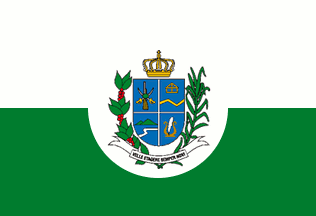 image by
Dirk Schönberger,
12 February 2013
image by
Dirk Schönberger,
12 February 2013Based on: http://pt.wikipedia.org/wiki/Silveiras_(S%E3o_Paulo)

Last modified: 2013-03-02 by ian macdonald
Keywords: sao paulo | silveiras |
Links: FOTW homepage |
search |
disclaimer and copyright |
write us |
mirrors
 image by
Dirk Schönberger,
12 February 2013
image by
Dirk Schönberger,
12 February 2013
Based on:
http://pt.wikipedia.org/wiki/Silveiras_(S%E3o_Paulo)
Horizontally divided white over green with the municipal arms in the centre on a white disk.
Official website at
http://www.silveiras.sp.gov.br
Dirk Schönberger,
12 February 2013
Silveiras was founded at the end of the 18th century by the Silveira family, originally as a ranch located on the São Paulo - Rio de Janeiro road. The municipality of Silveiras was established in 1842, seceding from Lorena, and inaugurated on 7 September 1844.
The flag of Silveiras is horizontally divided white-green. In the middle of the flag is placed a white disk charged with the municipal coat of arms.
Photo of the flag
http://euseguialice.blogspot.fr/2011/11/vista-da-estrada-pela-minha-casa.html
The coat of arms of Silveiras, designed by José Miranda Alves, was adopted on 11 January 1975.
The inner parts of the coat of arms [shield and charges] are a tribute to the founding acts and members of the settlement, as well as a representation of its geographical, historical, natural and arts features. The outer parts of the coat of arms [supporters] recall the time of foundation of the town and its main past sources of income, coffee and sugarcane. The shield is surmounted by the Portuguese Imperial Crown [instead of the mural crown widely used on Brazilian municipal coat of arms], since the first settlement was established in 1780, when Brazil was a colony of Portugal.
The classic shape of the shield is a tribute to the classicism and ethos of the refined society that lived in Silveiras in the 19th century; at the time, the wealthy family danced in the theatre [list of classic dances skipped] and in the salons of the rich coffee growers, who had their houses in the town, danced and declaimed Castro Alves*. The shield has a blue background, of the colour of the cloak of Our Lady of the Conception, the town's patron saint, quartered [by a thin white cross]. The upper left quarter represents a historical episode of the 1842 Revolution**, when 600 men from Silveiras fought against the governmental troops. The crossed swords represent armed struggle between Liberal and Conservatives. Over the swords are placed a gun and a kepi used by Caxias'*** Imperial soldiers, who suppressed the Revolution. The upper right quarter represents the ranch established by the Silveira, the founders of the town, and the first road named "New Road from Piedade to Santa Cruz". Or is a symbol of greatness and of the richness of the soil. The lower left quarter pictures the Serra da Bocaina mountains and river Paraitinga, whose source is located on the municipal territory. The Paraitinga merges with the Paraibuna to form the legendary Paraíba. The lower right quarter represents arts in Silveiras - literature, painting and music -, which peaked with maestro João Batista Julião****. The quill recalls the genealogical research made by Carlos da Silveira*****, of national fame. The motto "VELLE ET AGERE SEMPER NOVI" recalls the 1842 Revolution**, whose main fighting occurred in Silveiras.
http://www.valedoparaiba.com/cidadesdaregiao/?pagina=cidade&cidade=Silveiras&menu=967 - "enciclopédia VP" website
*Antônio Frederico de Castro Alves (1847-1871) was a Romantic poet ("Espumas Flutuantes", 1870), nicknamed the "Slave's Poet" for his abolitionist and republican poems ("O Navio Negreiro", 1880; "Os Escravos", 1883). http://www.academia.org.br/abl/cgi/cgilua.exe/sys/start.htm?sid=124 - Brazilian Academy of Letters website
**The 1842 Liberal Revolution broke out in Sorocaba. Led by the former Regent Antônio Feijó and by Brigadier Tobias de Aguiar, the uprising was joined by the towns of Taubaté, Pindamonhangaba, Lorena and Silveiras. When the rebels decided to march on Rio de Janeiro to overthrow the Conservative government, the Imperial power commissioned Duke of Caxias*** to stop them, which was quickly achieved. In 1844, the Liberals won the elections and the leaders of the 184 uprising were amnestied. http://www.historiatecabrasil.com/2010/03/revolucao-liberal-de-1842.html
***Luís Alves de Lima e Silva, Duke of Caixas (1803-1880) was known as the "Pacifier" or the "Iron Marshal". A main leader of the Conservative Party, he suppressed revolts in the provinces of Maranhão, Rio Grande do Sul, São Paulo and Minas Gerais. Caixas is listed on the "Register of National Heroes"; The Cadets of the Agulhas Negras Military Academy take the oath on his sword ("I receive Caxias' sword as the proper symbol of military honour").
****João Batista Julião (1886-1961) was among the founder of the São Paulo Music Institute (1927). He founded in 1946 the Choral Music School, part of the Campinas Catholic University. http://www.abmusica.org.br/html/fundador/fundador30.html
*****Carlos da Silveira (1883-1964) was member of the São Paulo
Institute of History and Geography (1934; President in 1956) and of
the Brazilian Institute of Genealogy. His main work, "Subsídios
Genealógicos" form Volume 3 of the Brazilian Library of Genealogy.
Silveira is the patron of Chair No. 1 of the Brazilian College of
Genealogy
http://www.cbg.org.br/novo/colegio/historia/patronos/carlos-da-silveira - Brazilian College of Genealogy website
Ivan Sache, 16 February 2013